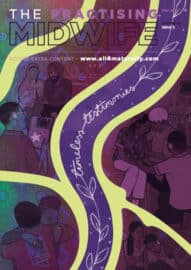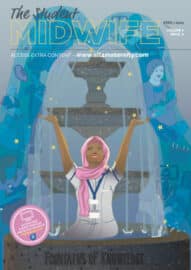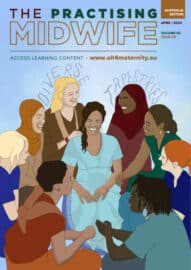Where to be Born during COVID-19? Positive practice to share
Sheena Byrom OBE – Midwife and Director All4Maternity
Mary Newburn – Member, Maternity Transformation Programme Stakeholder Council England
Sheena:
I have friends who are managing maternity services and feel overwhelmed and anxious when unable to offer the usual birth place choice options to pregnant women. They tell me they have no option. Home birth services are being suspended and freestanding midwife led care units (birth centres) closed. I was a head of midwifery myself, and I understand their concerns.
And yet it seems there is another way – please read on…
I saw an email on an eList from Sarah Noble, the Head of Midwifery at South Warwickshire NHS Trust. What caught my attention was Sarah’s message that Sarah and her team were continuing with their home birth service and access to their midwifery led unit for women booked with them. You can read the details here. I then learnt that other maternity services were doing the same. In their online information sheet for pregnant couples, the Chelsea and Westminster and the West Middlesex maternity services in London state –
We are committed to supporting choice and intend to keep all birth settings available (labour ward, birth centre, home birth and water birth) throughout this outbreak. To do this, we are working hard to make sure we have enough staff in all areas, and we have acquired additional resources to support transfers of women in urgent situations. If you have planned or would like to plan to give birth at home in the next few months, talk to your midwife who will ensure you have the most up to date information.
As communication began to increase, I read about the pop-up birth centres being created in hotels in the Netherlands, and I was directed to the KNOV’s guidelines on providing maternity care during this pandemic. They state;
Care is provided in midwifery practices as usual. Births as much as possible at home and women with mild complaints only and temperature below 38 will stay in primary care.
This seemed sensible to me.
A message then came through to me about a maternity service in Belfast, Northern Ireland, where managers and staff are striving to continue to offer choices to women and support them to stay away from hospital settings wherever possible. Seana Talbot, Maternity and Neonatal Service Manager at the Royal Jubilee maternity service Belfast, Northern Ireland shared this link with me which presents all options available to women and families during the pandemic. The maternity service is continuing to offer home birth, along with a midwife-led service in the hospital. Leslie Altic, a Belfast based doula said:
We understand how important it is for women to have choices, including midwife-led care and home birth. We understand that there may be times when the service might not be fully available, but we are delighted that the Belfast Trust has been able to sustain these key services.
Mary:
I have been very concerned to hear that options to have a home birth or to use a birth centre have shrivelled as the Covid-19 crisis has rolled in. At my local maternity unit in southwest London, the birth centre has become the area for women with Coronavirus to have their babies. I hope they get really good care and feel as safe, comfortable and special as possible.
Across London, for women who are healthy with an uncomplicated pregnancy, though freestanding birth centres are rare there has been good provision for home birth. But in the first week of April, notice after notice has suggested that opportunity was drying up fast.
A friend, 22 weeks pregnant, contacted me from Cumbria. The situation is similar there. The midwifery unit in Kendal has closed temporarily and the home birth service is suspended. She’s worried. It’s baby number two. The first was straightforward, she should be a shoe-in for a nice normal labour. She wants to labour where physiological birth is supported and away from the hospital where there is more exposure to the virus.
It doesn’t have to be this way. At the national Maternity Transformation Programme Stakeholder Council meeting on 31 March two service leads shared their approach to planning for the Covid-19 pressures and preserving and even extending opportunities for women to have safe and personalised care. Both services are extending provision for home births. Pippa Nightingale, Chief Nurse, Chelsea and Westminster Hospital NHS Foundation Trust, said that she and the Director of Midwifery, Victoria Cochrane, and the whole senior midwifery team are committed to supporting the physical and mental wellbeing of all staff in the maternity service during this challenging time. By doing this and ensuring safe staffing levels they have been able to focus on maintaining continuity of carer pathways ( 30% of women are on a continuity pathway) which has enhanced social distancing. Victoria says, ‘We have seen increased use of our alongside midwifery units and increased home birth bookings. We have been able to support these homebirth bookings by working together responsively and ensuring we support our community and caseload midwives. We also continue to work closely with a group ofindependent midwives ( who have had a bank contract with the Trust for three years now) utilising their skills in supporting the community and home birth service. They have also commissioned a private ambulance service to reduce the pressure on London Ambulance Service. Victoria said ‘By working collaboratively with the maternity team at London Ambulance Service together we have developed a joint standard operating procedure (SOP) to ensure that any necessary transfers from home are not delayed. This has been shared widely in the hope that others services may be able to use the same model.
Sarah Noble, Head of Midwifery, South Warwickshire Foundation Trust said that despite facing an increase in staff sickness they are coping well. Concentrating considerable attention on staff wellbeing those in work were working extra hours and covering bank shifts. They too have really focused on retaining continuity of carer (40% of the workforce are in continuity teams now) and they are actively encouraging women to consider home birth so as to reduce the numbers coming into hospital so that social distancing is easier to maintain and fewer families and midwives are exposed to the virus. (The OU does not have en suite labour rooms but one bathroom for two rooms, so they have additional challenges.) Sarah said, ‘We are actively encouraging MLU-suitable women to consider home birth.’ They have kept access to one alongside birth centre room for use as usual. A key part of the plan has been work with the West Midlands Ambulance Service (WMAS) ‘We have been working very closely with WMAS on a standard operating procedure (SOP) to reduce the need for an ambulance transfer.’ This has included identifying different levels of urgency for transfer with three categories. In the least urgent category, women will transfer in using their own car. ‘(WMAS) have assured us at this time that they have the capability to support our home birth service.’
I was thrilled to see this approach to addressing the obstacles. It’s so important to ask searching questions. What are all the things preventing us from realising our ambitions? Then think how would things would look without those obstacles, and how might the obstacles be tackled. Bring in more midwives with skills and experience in home birth, tick; preserve the strong base of continuity of carer teams, tick; commission private taxis to get around the bottleneck of calls to the London Ambulance Service in the capital, tick. Midwifery Unit Network has been calling for similar thinking, including proposing the creation of new pop-up birth centres close to, but separate from, hospitals to keep non-Covid+ and Covid+ women and birth partners well separated. This would create more social spaces for birth where the need for intervention is less common. A win win.
I shared these examples of thinking differently and continuing to deliver a maternity service with community-based care with the Chairs of Maternity Voices Partnerships across England and MSLCs in the other countries of the UK. They were really keen to share these examples locally and were looking for midwifery, NHS England and commissioning leadership and support to implement similar solutions on their patch.”
Conclusion
The International Confederation of Midwives suggest that ‘in countries where the health systems can support home birth, healthy women experiencing a normal pregnancy and with support from qualified midwives, with appropriate emergency equipment, may be safer birthing at home or in a primary maternity unit/birth centre than in a hospital where there may be many patients (even non-maternity patients) with Covid-19′. The Royal College of Midwives and the Royal College of Obstetricians and Gynaecologists in their latest Guidance for provision of midwife-led settings and home birth in the evolving coronavirus (COVID-19) pandemic highlight the positive impacts pf birth in midwife-led settings, and that they ‘remain of significant importance to prevent avoidable harm, and availability of midwife-led care settings for birth should therefore be continued as far as is possible during the pandemic’.
We are aware that many maternity services in the UK and beyond are under enormous pressure to centralise and feel constrained for many reasons including midwifery staffing levels and ambulance emergency cover. The purpose of this article is to provide encouragement and support by sharing links that may be useful. As the extent of staff sickness and self-isolating changes over time, there will be opportunity to re-assess the choice of place of birth provision offered to women in maternity services. We are planning to add others into this blog post who are able to offer interesting solutions, advice and guidance; please contact Sheena Byrom – sheena@all4maternity.com or leave a comment if you are willing to highlight your service to help others. Our aim is to build on successes to maximise the potential for safe, accessible and acceptable maternity care for all.
Maria Booker, Programme Director of Birthrights Charity commented:
‘We have produced a position statement to guide maternity services and service users. People are very welcome to get in touch with us for support or advice (see email below).
The NHSE guidance on delivering maternity services during the Coronavirus pandemic is explicit that services are expected to explore all alternative options before pulling usual services, including home birth or birth centre services. According to the RCM’s survey at the end of March, 45% of Trusts were offering homebirth It is a misconception that few trusts continue to offer home birth, around half are doing so’.
Useful contacts who have offered support:
Victoria Cochrane, Director of Midwifery at Chelsea and Westminster Hospital NHS Foundation Trust London Victoria.Cochrane@chelwest.nhs.uk
Sarah Noble, Head of Midwifery at South Warwickshire Foundation Trust Sarah.Noble2@swft.nhs.uk
Seana Talbot, Maternity and Neonatal Service Manager at Royal Jubilee Maternity Service Belfast, Northern Ireland seana.talbot@belfasttrust.hscni.net
Maria Booker Programme Director at Birthrights charity maria@birthrights.org.uk
More NHS services maintaining maternity services provision
Birmingham Women’s and Children’s NHS Foundation Trust’s Head of Midwifery, Rachel Carter:
‘we are still very much offering all choice options. We are proud to have the homebirth team, continuity of carer teams Keller and Noor continuing, our alongside midwifery-led unit and delivery suite. We offer waterbirth in all settings (taking into account RCOG COVID guidance) and have the kindest, most compassionate, caring and warmly smiling (masked) midwives to welcome women, birth partner and babies’.








